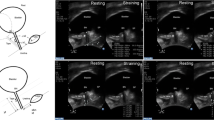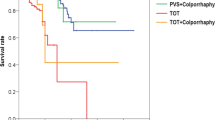Abstract
Introduction and hypothesis
The aim of the study was to assess the effectiveness of repeat mid-urethral sling after a failed primary sling for stress urinary incontinence.
Methods
A total of 112 women with recurrent stress incontinence after primary mid-urethral sling underwent a repeat procedure between 2000 and 2011. All patients had a preoperative clinical and urodynamic evaluation. Outcomes were divided into three groups: cured (no more leaks), improved (decrease of leaks), or failed.
Results
All patients had urethral hypermobility and 12.9 % had intrinsic sphincter deficiency [maximum urethral closure pressure (MUCP) ≤ 20 cmH2O]. Median MUCP was 41 cmH20. Overactive bladder was found in 5.7 % of women. The second sling placed was one of the following: retropubic Tension-free Vaginal Tape (49 %), transobturator tape (48 %), or mini-sling (3 %). No intraoperative morbidity was reported. After the second sling was placed, 68 (60.7 %) patients were subjectively cured and 18 (16.1 %) improved (76.8 % success overall) with a mean follow-up of 21 months. Success rates were 72.2 and 81.8 % for transobturator and retropubic slings, respectively, with no significant difference. Multivariable analysis showed higher odds of cure and improvement with the retropubic approach after adjusting for MUCP. Late complication rates were comparable to those observed after a first sling. Urodynamic parameters were not associated with postoperative success.
Conclusions
Repeat mid-urethral sling for recurrent female stress urinary incontinence is nearly 77 % successful in a group of patients with persistent urethral hypermobility. A retropubic approach might be preferred for patients with low urethral closure pressures.
Similar content being viewed by others
References
Ulmsten U, Henriksson L, Johnson P, Varhos G (1996) An ambulatory surgical procedure under local anesthesia for treatment of female urinary incontinence. Int Urogynecol J Pelvic Floor Dysfunct 7(2):81–85, discussion 85–86
Delorme E (2001) Transobturator urethral suspension: mini-invasive procedure in the treatment of stress urinary incontinence in women. Prog Urol 11(6):1306–1313
DeLancey JO (1994) Structural support of the urethra as it relates to stress urinary incontinence: the hammock hypothesis. Am J Obstet Gynecol 170(6):1713–1720, discussion 1720–1723
Fong ED, Nitti VW (2010) Review article: Mid-urethral synthetic slings for female stress urinary incontinence. BJU Int 106(5):596–608
Haab F, Richard F, Amarenco G, Coloby P, Arnould B, Benmedjahed K, Guillemin I, Grise P (2008) Comprehensive evaluation of bladder and urethral dysfunction symptoms: development and psychometric validation of the Urinary Symptom Profile (USP) questionnaire. Urology 71(4):646–656
Avery K, Donovan J, Peters TJ, Shaw C, Gotoh M, Abrams P (2004) ICIQ: a brief and robust measure for evaluating the symptoms and impact of urinary incontinence. Neurourol Urodyn 23(4):322–330
Haylen BT, de Ridder D, Freeman RM, Swift SE, Berghmans B, Lee J, Monga A, Petri E, Rizk DE, Sand PK, Schaer GN (2010) An International Urogynecological Association (IUGA)/International Continence Society (ICS) joint report on the terminology for female pelvic floor dysfunction. Int Urogynecol J 21(1):5–26
Haylen BT, Freeman RM, Swift SE, Cosson M, Davila GW, Deprest J, Dwyer PL, Fatton B, Kocjancic E, Lee J, Maher C, Petri E, Rizk DE, Sand PK, Schaer GN, Webb RJ (2011) An International Urogynecological Association (IUGA)/International Continence Society (ICS) joint terminology and classification of the complications related directly to the insertion of prostheses (meshes, implants, tapes) & grafts in female pelvic floor surgery. Int Urogynecol J 22(1):3–15
Nilsson CG, Palva K, Rezapour M, Falconer C (2008) Eleven years prospective follow-up of the tension-free vaginal tape procedure for treatment of stress urinary incontinence. Int Urogynecol J Pelvic Floor Dysfunct 19(8):1043–1047
Liapis A, Bakas P, Creatsas G (2009) Tension-free vaginal tape in the management of recurrent urodynamic stress incontinence after previous failed midurethral tape. Eur Urol 55(6):1450–1455
Stav K, Dwyer PL, Rosamilia A, Schierlitz L, Lim YN, Lee J (2010) Risk factors of treatment failure of midurethral sling procedures for women with urinary stress incontinence. Int Urogynecol J 21(2):149–155
Novara G, Artibani W, Barber MD, Chapple CR, Costantini E, Ficarra V, Hilton P, Nilsson CG, Waltregny D (2010) Updated systematic review and meta-analysis of the comparative data on colposuspensions, pubovaginal slings, and midurethral tapes in the surgical treatment of female stress urinary incontinence. Eur Urol 58(2):218–238
Lee KS, Doo CK, Han DH, Jung BJ, Han JY, Choo MS (2007) Outcomes following repeat mid urethral synthetic sling after failure of the initial sling procedure: rediscovery of the tension-free vaginal tape procedure. J Urol 178(4 Pt 1):1370–1374
Stav K, Dwyer PL, Rosamilia A, Schierlitz L, Lim YN, Chao F, De Souza A, Thomas E, Murray C, Conway C, Lee J (2010) Repeat synthetic mid urethral sling procedure for women with recurrent stress urinary incontinence. J Urol 183(1):241–246
Schierlitz L, Dwyer PL, Rosamilia A, Murray C, Thomas E, De Souza A, Lim YN, Hiscock R (2008) Effectiveness of tension-free vaginal tape compared with transobturator tape in women with stress urinary incontinence and intrinsic sphincter deficiency: a randomized controlled trial. Obstet Gynecol 112(6):1253–1261
Miller JJ, Botros SM, Akl MN, Aschkenazi SO, Beaumont JL, Goldberg RP, Sand PK (2006) Is transobturator tape as effective as tension-free vaginal tape in patients with borderline maximum urethral closure pressure? Am J Obstet Gynecol 195(6):1799–1804
Tsivian A, Neuman M, Yulish E, Shtricker A, Levin S, Cytron S, Sidi AA (2007) Redo midurethral synthetic sling for female stress urinary incontinence. Int Urogynecol J Pelvic Floor Dysfunct 18(1):23–26
Eandi JA, Tanaka ST, Hellenthal NJ, O’Connor RC, Stone AR (2008) Self-reported urinary continence outcomes for repeat midurethral synthetic sling placement. Int Braz J Urol 34(3):336–342
Van Baelen AA, Delaere KP (2009) Repeat transobturator tape after failed mid-urethral sling procedure: follow-up with questionnaire-based assessment. Urol Int 83(4):399–403
Palva K, Nilsson CG (2009) Effectiveness of the TVT procedure as a repeat mid-urethra operation for treatment of stress incontinence. Int Urogynecol J Pelvic Floor Dysfunct 20(7):769–774
Conflicts of interest
None.
Author information
Authors and Affiliations
Corresponding author
Rights and permissions
About this article
Cite this article
Meyer, F., Hermieu, J.F., Boyd, A. et al. Repeat mid-urethral sling for recurrent female stress urinary incontinence. Int Urogynecol J 24, 817–822 (2013). https://doi.org/10.1007/s00192-012-1941-6
Received:
Accepted:
Published:
Issue Date:
DOI: https://doi.org/10.1007/s00192-012-1941-6




